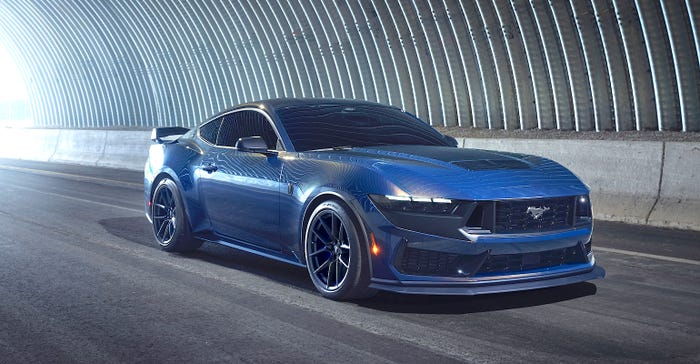Ultra-Performance ‘Dark Horse’ Model Highlights New Mustang Announcement
In maybe the final hurrah for the internal combustion pony car, Ford reveals the latest Mustang refresh.

2024 Ford Mustang Dark HorseImage courtesy of Ford Motor Co.
While competitors like the Dodge Challenger and Chevrolet Camaro are riding off into the sunset to make way for electrified replacements, Ford has refreshed the original pony car, announcing an updated Mustang for 2024 that may give us a look at the final edition of this car powered by internal combustion.
“Investing in another generation of Mustang is a big statement at a time when many of our competitors are exiting the business of internal combustion vehicles,” said Jim Farley, CEO of Ford Motor Company. “Ford, however, is turbocharging its ICE growth plan, adding connected technology, opinionated derivatives, and hybrid options to our most profitable and popular cars,” he said.
The Mustang will continue with its EcoBoost 2.3-liter direct-injected, turbocharged I-4 base engine and its optional naturally aspirated 5.0-liter Coyote V8 engine with available six-speed manual transmission. For this final edition, power of the V8 for the Mustang GT is boosted to 485 hp, while a new special edition model dubbed “Dark Horse” is targeting 500 horsepower for its version of the engine.
Dark Horse
As the new top-of-the-line model, the Dark Horse is the new Mustang flagship. It serves as the foundation for Ford’s racing plans, with multiple racing variants planned for different racing series such as NASCAR, Australian Supercars, global GT3 and GT4 sports car racing classes, and NHRA Factory X racing classes. There will even be a spec Mustang Dark Horse racing series, just for these cars.
These racing cars will be derived from the Mustang Dark Horse, which is offered with two upgraded track-focused versions: Dark Horse S for track days and Dark Horse R for racing. In either case, the Dark Horse is a Mustang that is substantially upgraded to withstand the rigors of track use.
The Dark Horse starts with dual throttle bodies for increased air intake compared to the GT’s version of the Coyote V8. The added airflow will let the engine spin faster to produce higher peak power, so to ensure that the faster-spinning reciprocating parts don’t fly apart, the Dark Horse’s engine employs the same high-strength connecting rods used previously in the supercharged 760-hp Mustang Shelby GT500.
The extra power from the Dark Horse’s engine means extra heat, so the car is equipped with an auxiliary engine oil cooler, a rear axle cooler and a unique and lighter-weight radiator with improved cooling capability and more powerful cooling fans to improve endurance and recovery.
In the Dark Horse, this engine drives through a Tremec TR-3160 6-speed manual transmission first employed in the Mustang Shelby GT350. The driver shifts this gearbox using a 3D-printed titanium shift knob and the transmission is aided by a special Mustang Dark Horse transmission oil cooler.
There is a paddle-shifted 10-speed automatic transmission available for drivers who don’t like the idea of a clutch pedal. From the transmission, power is routed to the rear axle through a torque-sensing Torsen differential that ensures the power reaches the tire that has grip.
Mustang Dark Horse handling is upgraded with standard continuously adjustable MagneRideshocks that adapt wheel and tire movement to the conditions 1,000 times per second with the response based on driving surface and the driver-selected driving mode.
Suspension control and steering response are both enhanced by a lightweight strut tower brace and a K-bar to the firewall that stabilize the strut towers so that the suspension and steering can work from a stable foundation.
The shocks are backed by a larger rear sway bar. NACA air ducts direct cooling air flow to monstrous Brembo front 6-piston brakes with 13.9-inch rotors slow the car for corners. Standard tires are Pirelli P Zeros with staggered fitting wheels (19-inch-by-9.5-inch front and 19-inch-by-10-inch rear wheels). The optional Handling Package also adds stiffer springs, larger front and rear sway bars and wider Pirelli Trofeo tires and 19-inch-by-10.5-inch front and 19-inch-by-11-inch rear wheels.
For still more technology, the Carbon Revolution-supplied carbon fiber wheels seen previously on both the Shelby GT350 and GT500 are also available to reduce unspring weight and rotational mass. The Handling Package also includes a unique rear wing with an integrated Gurney Flap, which is a lip on the wing’s trailing edge that is known to dramatically increase downforce with only a slight increase in drag. It is named for the late racer and engineer Dan Gurney, who innovated this on his Indy car.
Track Ready
For the track-only versions, the Dark Horse loses unneeded comfort and convenience items and swaps Department of Transportation-certified parts for racing-approved items. The Dark Horse S includes a full FIA-certified safety cage, safety nets, a race seat with safety belts, a quick-disconnect race steering wheel (for ease of driver ingress/egress), electrical master disconnect switch, and a fire suppression system.
A valuable performance upgrade is the substitution of Multimatic DSSV shock absorbers that provide even finer control of suspension movements, plus adjustable springs for setting the car’s ride height and corner weights and camber plates that permit adjustment to the camber of the front wheels by changing the upper mounting point of the suspension struts.
In place of the production Mustang cockpit controls, the Dark Horse S has a racing panel that houses switches and knobs for the headlamps, side indicators, windshield wipers, mirror adjusters and a rain light. It has a pit lane speed limiter and a racing data acquisition display system to keep the driver informed. Sometimes racers want to demonstrate the experience, so there is an optional single passenger seat to give rides and to receive feedback from ride-along instructors.
As you’d expect from a race car, the Mustang Dark Horse S features hood pins to prevent the hood from flying open at speed, front and rear tow hooks for recovering broken or crashed cars, an adjustable rear wing for added downforce and a racing exhaust system.
The Dark Horse R is meant for actually wheel-to-wheel competition, and not just solo track laps, so it is even heavier-duty. The significant improvements are seam welding on the car’s unibody to increase rigidity over the factory spot welding and a racing-approved explosion suppressing fuel cell in place of the factory gas tank. It also rolls on racing-only wheels in place of the street-legal wheels, which are typically heavier and more durable than racing wheels.
“Both Dark Horse S and R have been further enhanced for performance and stripped of almost every unneeded comfort, keeping only what is needed to provide better performance,” said Ed Krenz, Ford Mustang chief nameplate engineer.
Affordability
Affordable performance has always been the Mustang’s hallmark, so the base EcoBoost and the V8 GT model lack these Dark Horse upgrades, but the refreshed 2024 versions of these cars carry plenty of changes and improvements to appeal to customers.
Both engines are available with a Getrag 6-speed manual transmission or 10-speed automatic.
While the Dark Horse is available only as a hardtop coupe, the base and GT versions are also available as convertibles. Mustang has a simple, one-touch convertible top activation with a single-handle center latch that opens and closes the fully lined and insulated fabric roof. Ford points out that the compact folding roof design and independent rear suspension save trunk space so there is room for two golf bags, which is probably important in the convertible rental car market when people fly to sunny destinations and rent Mustangs to drive to the golf course.
On the other hand, enthusiast drivers can adjust steering effort, engine response, automatic transmission shifts, and electronic stability control settings through six available Drive Modes to personalize their car’s behavior. The available Drive Mode settings are Normal, Sport, Slippery, Drag, Track, and a customizable setting that has as many as six individual profiles.
For a higher level of performance without opting for a Dark Horse, both Mustang GT and EcoBoost models are available with an optional Performance Pack. This adds track-focused features such as a front strut tower brace, Torsen limited slip differential, MagneRide active suspension, wider rear wheels and tires, and larger, 390-millimeter front and 355-millimeter rear Brembo brakes. For the GT, the Performance Pack also adds brake ducts for improved brake cooling and a standard auxiliary engine oil cooler. Optional Performance Pack features include Recaroseats and active exhaust.
The GT’s manual transmission includes standard rev-matching that matches engine RPM to vehicle speed for the destination gear when the clutch is engaged for professional-grade downshifts while braking.
Recognizing the popularity of drifting for rear-drive cars like the Mustang, 2024 Mustangs with the Performance Pack include an electronic drift brake in place of the traditional mechanical hand brake. This helps drivers slide the car for dramatic tire-smoking action.
Glass Cockpit
The 2024 Mustang’s dashboard features a single pane of glass that incorporates a 12.4-inch digital instrument cluster ahead of the driver and a 13.2-inch SYNC4 infotainment display in the center section of the dash.
These displays are powered by the video game Unreal Engine 3D creation tool seen previously in the Cadillac Escalade and Lyriq. “We’re taking advantage of every pixel,” promises Craig Sandvig, Ford Mustang interaction design manager. “We can be creative in showing necessary driving information and give the driver control of selecting colors, classic Mustang gauges or even a ‘calm’ screen where only minimal details are displayed.”
The default instrument gauge setting is an ultra-modern, copper appearance theme like the one in the Mustang Mach-E, but everything is adjustable. Drivers who fondly remember 1980’s-vintage Mustangs will be pleased to see an impressive virtual recreation of that car’s dashboard. However, they might be less thrilled by the virtualization of most of the car’s physical switches.
“Removing some of these physical buttons, such as radio and climate control, and integrating them into a digital display was popular in research with Millennials, Gen-Z and traditional Mustang drivers alike,” said Ricardo Garcia, Ford interior design manager. This seems likely to be true among those younger demographics, but probably not with many drivers old enough to remember the vintage instrument panel that is represented among the choices.
Better Safe than Sorry
In addition to the infotainment gadgetry, of course the new Mustang extends the reach of modern safety and convenience features. The 2024 Mustang comes with Ford Co-Pilot360, which includes Speed Sign Recognition, Intelligent Adaptive Cruise Control with Stop-and-Go, Lane Centering Assist, Evasive Steer Assist and Reverse Brake Assist. Active Pothole Mitigation, which is part of the Performance Package, continually monitors suspension, body, steering and braking input and adjusts suspension response accordingly. Hopefully, this provides a better chance of expensive low-profile tires and large-diameter wheels surviving pothole encounters.
Ford’s FordPass smartphone app includes free remote features such as remote vehicle start and stop, door locking and unlocking, scheduling a start time, locating the vehicle, and vehicle health and status checks. The FordPass app provides important vehicle information available to users, including fuel and oil levels, service history and warranty information.
Look for the 2024 Mustang next summer.
About the Author(s)
You May Also Like





